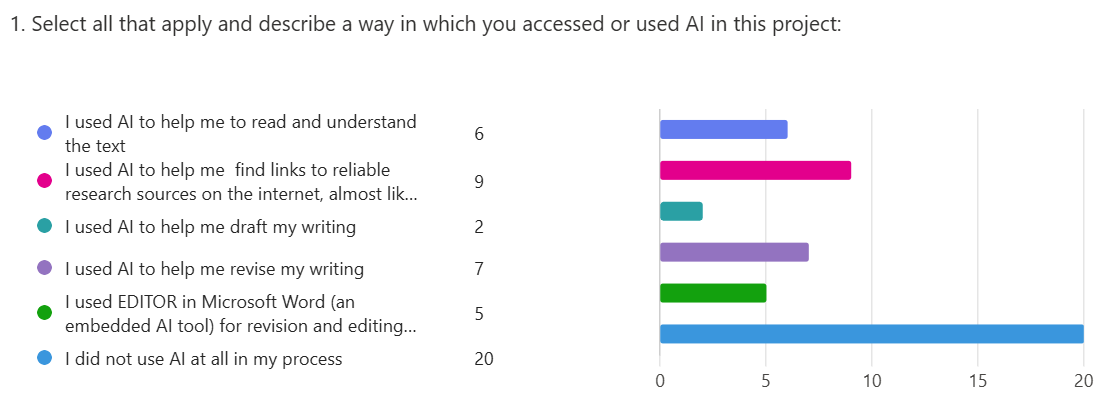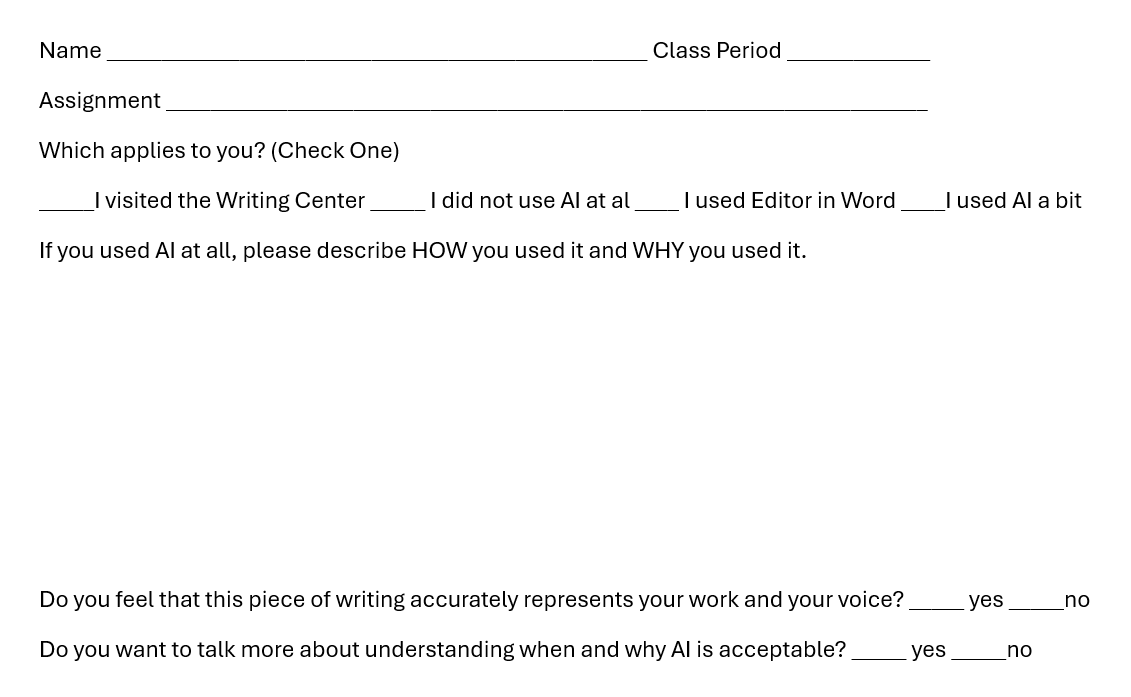The Transparency Survey
A tool for reasoning about AI in writing
The Important Work is a space for writing instructors at all levels—high school, college, and beyond—to share reflections about teaching writing in the era of generative AI.
This week’s post is by Brett Vogelsinger, a high school English teacher in Pennsylvania. Brett’s new book, Artful AI in Writing Instruction: A Human-Centered Approach to Artificial Intelligence in Grades 6-12 investigates how teachers can carefully weigh the inclusion of AI tools at different stages of the writing process. It includes interviews with teachers and students as well as use-tomorrow lessons to help guide classrooms through this new landscape to artful results and stronger writers. You can learn more about Brett’s work on his website and read his previous post for The Important Work here.
If you’re interested in sharing a reflection for The Important Work, you can find information here.—Jane Rosenzweig
At this point in the year, my students in AP Literature and Academic English 10 know several things about my stance on AI.
I’m open to talking about any opinion on it.
I listen a lot.
I use AI for some things and avoid it for others.
I am transparent whenever I share something student-facing that includes any use of generative AI.
In short, I’m trying to model what it is to be cautiously curious, to engage in reflective reconnaissance, and to share what I learn along the way.
The moral reasoning my students and I do around this topic may be one of the most interesting things it has brought into my classroom—a place that is technology-heavy some days and entirely grounded in paper notebooks on others—and for this reason, I recently invited some honesty and feedback from my students.
In two assignments in two different courses, I neither expressly forbade the use of AI nor did I encourage it. But here’s what I did do:
Prior to the start of the writing project, we had an “Is It Cheating?” lesson, in which I demonstrated, live on the big screen, various uses of AI for an assignment similar to the one we would be working on. We reached consensus as a class about what uses clearly overstepped the bounds of academic integrity and what uses had potential to push our thinking. Ultimately, students left understanding that “using AI” can include a range of actions, and that even the Editor tool built into their MS Word program involves “use” of this technology.
During the writing process, we occasionally hearkened back to our “Is It Cheating” lesson with brief conversations that never sidetracked our important work—the thinking and writing—but illuminated possibly productive applications. An example: “You just read your draft aloud to a partner and highlighted any bumpy sentences. One of them is still giving you trouble. How would you feel about asking AI for three potential rewrites? You don’t have to use any of the suggested revisions in their entirety, but might seeing them open a new approach to the grammar of that gnarly sentence?”
Unannounced, at the end of the writing process, I gave a “Transparency Survey.” In AP Lit, this was online, and in Academic English 10 it was a small sheet of paper to attach to the printed papers they were turning in.
Here is what the survey looked like for my AP Literature students (you can click here for a copy you can download if you want to try it out):
One of my ongoing curiosities is whether students will speak candidly about their generative AI use when they know they are working with a teacher who approaches this technology with an open mind. I am curious about the nature of their use and how they feel about it.
I also want to emphasize to them that LLMs are optional and part of a broader spectrum of support for writers. Artificial intelligence replaces neither the writer nor the classroom community of writers.
I want to allow for the fact that students will sometimes use artificial intelligence in ways that did not feel good in the end, and they can admit that to me. I am learning that, like any kind of cheating, flagrant misuse of generative AI does not sit well with the conscience.
So in both surveys, I thought it was important for students to weigh in on whether or not their voice shines through in their work and give them the chance to talk to me more about it if they had an “uh-oh” epiphany about their work on turn-in day.
Almost every student I surveyed felt their finished work presented their own voice as writers.
Finally, on the AP Lit survey, I wanted feedback on whether this kind of transparency survey might be helpful in maintaining academic integrity. Of my AP Lit students, 85% feel that it would be helpful.
In a sample size this small, the numbers do not mean a whole lot. So let’s center student voice again and take a look at what students themselves had to say in their open-ended answers.
The first question on the survey asked them to select all options that described their use of AI. Here were the results based on 40 responses total:
After showing them the results, I asked if they felt that one of these situations has the potential to overstep more than the others. Without any names attached to these results projected up on the screen, they quickly identified “I used AI to help me draft my writing” as being potentially problematic. We slowed down and talked about the range of uses that could be referring to.
Students were also apprehensive about “I used AI to help me to read and understand the text,” pointing out that this could lead to cheating akin to only reading the CliffsNotes, and they’re right. However, some students had taken on epics like The Iliad or Inferno to read for this project, or Greek plays in verse like Prometheus Bound. At home, I had witnessed my own son recently use AI to help him scaffold his reading of Emerson’s dense prose for AP Lang and rather quickly pull that scaffolding away to keep reading on his own. I wondered whether any of my students had done the same.
So the next question on the survey mattered quite a bit: “Describe any reasoning for your decisions in Question #1. Tell me about the WHY behind your choices.”
On using AI to support reading, Elizabeth wrote:
I read Dante’s Inferno, and the translation was written in verse. I initially had a hard time adjusting to the style as it is drastically different from what I normally read. As a result, I had a harder time understanding the first couple of cantos, so I took what I thought I understood, brain dumped into AI, and asked if I understood it correctly. If I did, I would move on, if I didn’t, I would ask questions and reread the passage after. Around 1/3 of the way through the book I stopped using AI completely.
Mark, who used AI to support drafting had this to say:
I used AI to help draft ideas that I picked apart to help find the best ideas that I then used to spin off into my own thoughts to create my script for my presentation.
And then there was a whole range of other thinking across the class:
Alaina: After a few drafts of my conclusion, there were two sentences that I couldn’t find a clear wording for and I felt they were getting too convoluted for my presentation. I decided to ask AI to give me a few options for ways to rewrite them so I combined some of those ideas to make what I was trying to say more articulate.
Talia: Personally, I do not think AI usage is ethical, especially in a literature situation. . . Everything AI can tell me from a prompt I can learn from my own research.
Smaran: I always use the Microsoft Word Editor after every essay or project . . . Also, I used AI to try to find a scholarly source based on my thinking.
Ainslie: I’m not sure how to use AI in a way that maintains my thinking and voice and the integrity of the project. I also don’t see the [point of ] wasting that sort of energy and adding to my carbon footprint if I could use my brain.
Erin: I do not like AI and do not like using it in regard to my writing. I think it takes away the work of real writers and is harming us a lot more than it’s helping us.
Johan: I used the Google AI on my phone to look for different examples of Norse mythological influences in contemporary media.
Cassie: I didn’t use AI at all in this project. I don’t like using AI because it feels as though I am cheating myself out on my learning. This is an AP class; things are supposed to be difficult.
I want to pause here and marvel at the range of thinking and reasoning that came out of these two simple questions. I’ve been saying it for years now: Students are not a monolith in their opinions on AI!
And my job is NEVER to talk them into using it as part of their writing process. Rather, my job is to give them opportunities, instruction, and feedback that helps them to become skilled writers.
I also feel it is my job to help build their reasoning skills around AI, to be ruthlessly reflective, to know what boundaries they should never cross if they do choose to use AI in their writing process. Because if we do not do that, students are left to dive into this deep and perilous ocean of generated text on their own.
If students head to college without solid foundational writing skills and without adult guidance that has helped them hone their reasoning skills on artificial intelligence with opportunities to be transparent about their use, students are more likely to succumb to cheating with it when it comes to crunch time.
How does this kind of survey look with younger students, outside of an Advanced Placement environment?
At the end of a unit where we studied Cormac McCarthy’s The Road—perhaps the strangest novel most of the sophomore class had ever read—I presented my students with six different writing prompts on the day of their in-class assessment in an 83 minute block.
They could choose two prompts to veto, writing no response to them.
They could choose any three of the prompts to write about in short answer form, on paper, during the test period. This provided unvarnished thinking and interpretation from my students with no influence of AI.
Then, students needed to choose a fourth prompt from the list and start drafting their response in a handwritten rough draft. At the end of the period, they turned in the three handwritten short answer pieces and took home the start of the draft on their fourth one. That draft would return a week later stapled to a typed final copy of a 2+ page essay.
On turn-in day, each student also had to fill out the following form and staple it to their finished copy.
Like my advanced senior class, their responses were varied:
60% of the students said they used Editor within Microsoft Word and slightly fewer (55%) said they “used AI a bit.” Currently, the major LLMs are all blocked on their school laptops, so they would have done this on their personal devices.
A few students made appointments at the Writing Center, and notably one of them expressed that he worked with the same tutor as he had previously because of a productive past experience. Human connections matter in our writing.
Only about 50% of the students felt they wanted more time in class spent talking about when and why AI use is acceptable, and I wonder, is this because they feel I’ve given them enough direction, or because they do not want to uncover more reasons to restrain their use?
When I asked students to share how and why the used artificial intelligence, here are some of the responses I received:
Mason: I used the sentence builder and synonym word changer in Editor to use bigger and better words and make my writing sound professional.
Siena, a student who both visited our school’s Writing Center and used some AI: I used AI to help me with my thesis statement. It helped me determine if my thesis was good. I also used AI to help me find similar words I used a lot throughout my essay.
Callen, using a prompting strategy I demonstrated in class during the “Is It Cheating?” lesson: I used AI on only one of my sentences and I asked it to rephrase the words in the sentence to make it flow better. But I asked it to keep as many words as possible so it still sounded like my idea.
Perry: I had a bland title but I had a couple of good titles too and I asked it for its opinion. I’m never really good at conclusion sentences, so I had a good copy and asked it if the conclusion sounded good. I asked for its opinion.
Malika, a Russian-speaking student learning English: I used AI when I try to translate and my translation was wrong.
This sample shows the array of uses students felt were within the bounds of academic integrity.
Transparency can help us to craft a lesson for the next unit that builds their confidence in a way that prevents them from turning to AI. Transparency can also help students to interrogate their own process, engaging in valuable metacognition.
In the future, if my students know a survey like this is coming at the end of a writing project, they can think about the implicit boundaries these reflections create as they work through the plethora of decisions it takes to compose an essay.
Just like my AP Literature students, 100% of the Academic 10 students felt that their writing accurately represented their work and their own voice, and I mostly agree with that self-assessment.
Were their final essays somewhat more polished than the handwritten work from the first part of the test? Yes.
Did they show me evidence of their writing process and reflect on that process? Yes.
Did this process feel better than condemning all artificial intelligence usage and playing detective as I tried to grade their work? Most definitely, yes.
Let’s seize the moment in the evolution of writing and writing instruction to truly listen to students so that we can meet their needs. When something troubles us in the results of a transparency survey, let’s articulate to our classes what bothers us and why, modeling how to reason. And let’s recognize the innovative uses students discover that have not occurred to us yet, but get us talking and reasoning together as a class.
Dear reader, you may agree or disagree with students about whether their uses of AI are conducive to learning, but what I think we can all agree that asking students to open up about how and why they are using artificial intelligence illuminates more clearly what support we can give them in our very human work of writing instruction.
Like the act of writing itself, all of this is messy. But with transparency, some of it can be really rewarding too.







I've been using the changes wrought by AI as an opportunity to reassess what I want students to learn from their reading and writing and discussing. What should they be learning that an AI-written essay can't replace? I appreciate how you're encouraging students to be reflective about their writing process and alert to ethical choices they face. Those are practices worth teaching/encouraging.
Brett, what an excellent example of empowering students and giving them agency in these decisions about whether and how to use AI. I love the metacognition and the reflection that your process has built into it. I'm going to share this with my teachers!